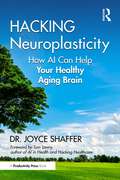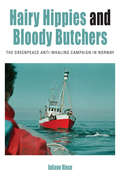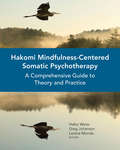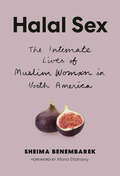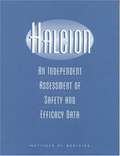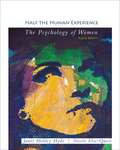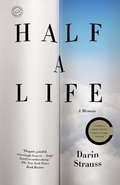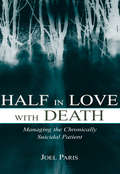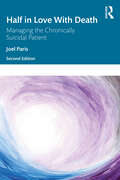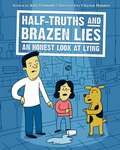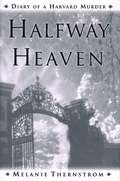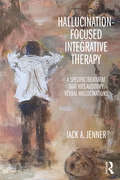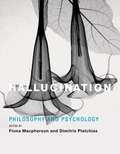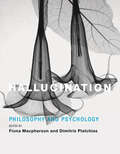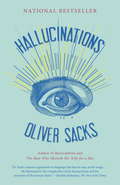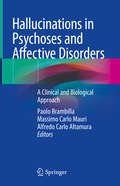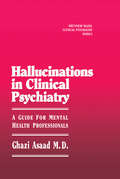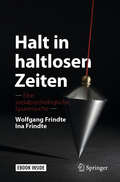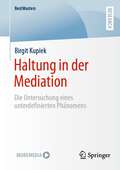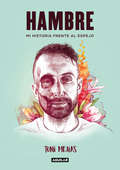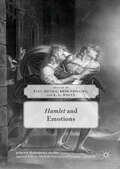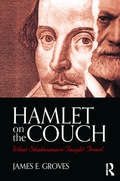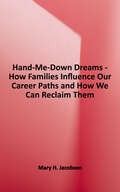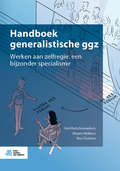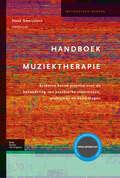- Table View
- List View
Hacking Neuroplasticity: How AI Can Help Your Healthy Aging Brain
by Joyce ShafferNeuroplasticity is the ability of neural networks in the brain to change through growth and reorganization. It is when the brain is rewired to function in some way that differs from how it previously functioned.How does aging affect neuroplasticity? As we grow older, plasticity decreases to stabilize what we have already learned. What influence does the aging process have on memory? Forgetfulness can be a normal part of aging. As people get older, changes occur in all parts of the body, including the brain. As a result, some people may notice that it takes longer to learn new things, they don't remember information as well as they did, or they lose things like their glasses. This book on evolving neuroscience is unique in its lifespan focus on driving neuroplasticity in a positive direction to influence the Flynn effect of increasing human intelligence as the preferred way to prevent, delay onset, and/or reverse dementia. It considers potential impact from the first moments of life through end of life. It includes intergenerational activities. Its inclusion of centenarians and supercentenarians provides examples of “Super Agers” who have maintained and/or increased neurocognitive capacity, often with a health span that approximated their vigorous longevity. It discusses the use of the Artificial Intelligence (AI) revolution to refine, personalize, and broaden our global reach to enhance the Flynn effect as the preferred effort to improve global statistics on neurocognitive functioning at any age. Driving neuroplasticity in a positive direction at all ages is urgent.With this book’s focus on evidence-based interventions at any age which can have physical, emotional, neurobiological, neurochemical, immunological, and social health benefits, it is a unique overview and application of evolving neuroscience to address the UN/WHO Decade of Action for Healthy Ageing for All.
Hairy Hippies and Bloody Butchers: The Greenpeace Anti-Whaling Campaign in Norway
by Juliane RieseIn the popular imagination, no issue has been more closely linked with the environmental group Greenpeace than whaling. Opposition to commercial whaling has inspired many of the organization's most dramatic and high-profile "direct actions"-as well as some of its most notable failures. This book provides an inside look at one such instance: Greenpeace's decades-long campaign against the Norwegian whaling industry. Combining historical narrative with systems-theory analysis, author Juliane Riese shows how the organization's self-presentation as a David pitted against whale-butchering Goliaths was turned on its head. She recounts how opponents successfully discredited the campaign while Greenpeace struggled with internal disagreements and other organizational challenges, providing valuable lessons for other protest movements.
Hakomi Mindfulness-Centered Somatic Psychotherapy: A Comprehensive Guide to Theory and Practice
by Greg Johanson Lorena Monda Halko WeissThe authoritative text on Hakomi methods, theory, and practice. Hakomi is an integrative method that combines Western psychology and body-centered techniques with mindfulness principles from Eastern psychology. This book, written and edited by members of the Hakomi Institute-- the world's leading professional training program for Hakomi practitioners--and by practitioners and teachers from across the globe, introduces all the processes and practices that therapists need in order to begin to use this method with clients. The authors detail Hakomi's unique integration of body psychotherapy, mindfulness, and the Eastern philosophical principle of non-violence, grounding leading-edge therapeutic technique in an attentiveness to the whole person and their capacity for transformation.
Halal Sex: The Intimate Lives of Muslim Women in North America
by Sheima BenembarekAn unprecedented glimpse into the sex lives of female and gender-expansive Muslims living across Canada and the United States.In the Muslim world, sex is permissible (or halal) only within the confines of marriage. Outside of wedlock, the act is considered haram, a sin of the faith. Girls are taught to protect their virginity; their mothers, if not forgoing &“the talk&” altogether, obscure the facts with elliptical language and metaphors.So, what happens when immigrants and the children of immigrants set about pursuing an open and active sex life on a more sexually liberated continent, amid western peers and attitudes? The six deeply personal stories in Halal Sex attempt to answer this question, bringing a hushed conversation out into the open.Within these pages you&’ll meet Azar, a non-binary trans Sufi; Bunmi, a Nigerian navigating shame and Tinder; Eman, a lesbian stand-up comic in an interfaith marriage; Taslim, a virgin in her forties struggling to erect healthy boundaries; and Khadijah, an exotic dancer and sex worker.With great empathy, Sheima Benembarek makes space for the honesty and vulnerability of each participant and handles their stories with gentleness and care. What emerges is a tapestry of a diverse Islam—encompassing a wide variety of cultural and religious and socioeconomic backgrounds—and a frank, feminist contribution to the advancement of Muslim sexual education and pleasure.
Halcion: An Independent Assessment of Safety and Efficacy Data
by Committee on Halcion: An Assessment of Data Adequacy ConfidenceRegulatory agencies within the United States and the United Kingdom, among several other countries, have reviewed extensively the safety and efficacy of Halcion (triazolam)--a once commonly used hypnotic drug. Concerns began to emerge about the safety of Halcion when a Dutch physician reported a possible link between it and a syndrome that included such effects as depression, amnesia, hallucinations, and increased anxiety. In addition, in 1991 its manufacturer, Upjohn, noted that "errors had been identified in a report of one of the clinical studies included in the original" application for approval. Since then, the drug has been removed from the market in several countries, whereas in the United States and Canada, the drug's labeling has been modified to reduce the recommended dose and duration of treatment and to heighten awareness of possible side effects. Yet different data and analyses have resulted in conflicting messages that are difficult to reconcile and interpret. In response to a request from the Food and Drug Administration to resolve these controversial issues related to the safety and efficacy of Halcion, this IOM book assesses the adequacy of the drug's clinical trials; the quality and quantity of data on adverse reactions; overall confidence in the data on effectiveness, adverse events, and side effects at different doses; and whether additional studies are needed.
Half The Human Experience: The Psychology of Women
by Janet Shibley Hyde Nicole Else-QuestOffering a clear, comprehensive presentation, HALF THE HUMAN EXPERIENCE, 8E delivers an authoritative analysis of classical and the most current research from a feminist psychology viewpoint. It thoroughly examines the balance of cultural and biological similarities--and differences--between the genders, noting how these characteristics may affect issues of equality as well as how men and women behave toward one another. It provides a strong foundation for understanding the influences of gender, race, and ethnicity on psychology and society, as well as strategies for thinking critically about pop culture versus academic feminism as it relates to psychology.
Half a Life
by Darin StraussIn this powerful, unforgettable memoir, acclaimed novelist Darin Strauss examines the far-reaching consequences of the tragic moment that has shadowed his whole life. In his last month of high school, he was behind the wheel of his dad's Oldsmobile, driving with friends, heading off to play mini-golf. Then: a classmate swerved in front of his car. The collision resulted in her death. With piercing insight and stark prose, Darin Strauss leads us on a deeply personal, immediate, and emotional journey--graduating high school, going away to college, starting his writing career, falling in love with his future wife, becoming a father. Along the way, he takes a hard look at loss and guilt, maturity and accountability, hope and, at last, acceptance. The result is a staggering, uplifting tour de force.Look for special features inside, including an interview with Colum McCann.Join the Circle for author chats and more.RandomHouseReadersCircle.comFrom the Trade Paperback edition.
Half in Love With Death: Managing the Chronically Suicidal Patient
by Joel ParisHalf in Love With Death presents a new way for therapists to manage chronically suicidal patients, an incredibly challenging task for clinicians and one where an insufficient amount of literature exists to guide professionals. Author Joel Paris suggests an approach that defies conventional wisdoms about whether suicide can be predicted or prevented. He asserts that managing chronically suicidal patients begins with tolerating suicidality, understanding the inner world of patients, avoiding repeated hospitalizations, and focusing on life situations that maintain suicidal ideas and behaviors. Each chapter in the book develops a theoretical perspective based on empirical data, and many are illustrated by clinical examples. Topics addressed throughout the text include:*distinctions among various types of suicidality;*the inner world of the chronically suicidal patient, with a particular focus on pain, emptiness, and hopelessness;*the relationship between chronic suicidality and personality disorders, especially the category of borderline personality;*the effectiveness of psychotherapy and pharmacotherapy for chronically suicidal patients; and*the risks of litigation in managing this patient population. This volume is a crucially important resource for clinicians who treat chronically suicidal patients, as it fills a gap in existing literature and provides enlightened guidelines that stem from a large body of research in the field.
Half in Love with Death: Managing the Chronically Suicidal Patient
by Joel ParisThe second edition of Half in Love with Death gives therapists new tools to help manage chronically suicidal patients. Clinicians will learn how to tolerate suicidality, understand the inner world of patients, avoid repeated hospitalizations, and focus on life situations that maintain suicidal ideas and behaviors. This new edition includes a number of major updates and a new chapter on the epidemiology of suicidality. Each chapter develops a theoretical perspective based on empirical data, and many are illustrated by clinical examples. Topics addressed throughout the text include: Distinctions among various types of suicidality The inner world of the chronically suicidal patient, with a particular focus on pain, emptiness, and hopelessness The relationship between chronic suicidality and personality disorders, especially the category of borderline personality The effectiveness of psychotherapy and pharmacotherapy for chronically suicidal patients The risks of litigation in managing this patient population This is a crucially important resource for clinicians who treat chronically suicidal patients, one that provides enlightened and evidence-based guidelines.
Half-truths And Brazen Lies
by Kira Vermond Clayton Hanmer<P>Do you believe in telling the truth? Sure you do. But even that's a lie -- because we all lie. Whether to protect a friend, to make someone feel better, or to avoid telling even bigger lies later, lying is actually central to human nature. Usually we're taught that lying is bad, and that's that. But in reality, it's rarely so black and white. <P>Kira Vermond's latest book answers questions like: Why do we lie? What types of lies are there? What are the consequences of lying? What methods are used to detect lies? And when is it okay or even good to lie? <P>From forgeries and hoaxes to plagiarism and placebos, Half-Truths and Brazen Lies offers historical anecdotes, scientific studies, and sociocultural analyses to help unpack the complex world of untruths. Told in a witty, conversational tone with an index and full-color illustrations, the book takes a thorough, nuanced approach to a fascinating aspect of human behavior.
Halfway Heaven: Diary Of A Harvard Murder
by Melanie ThernstromA few days before the end of spring term, an anonymous note arrived atThe Harvard Crimson. It contained a photograph of a student and a typed message: "Keep this picture. There will soon be a very juicy story involving this woman. " Now, the critically acclaimed author of The Dead Girl reveals the never-before-told story of two girls--one from Ethiopia, the other from Vietnam--for whom admission to Harvard was like "halfway heaven," the stepping stone to the American Dream that would ensure success for them and their families; and how they met instead with the darkest of all fates: a tragedy that might have been prevented. Based on Melanie Thernstrom's article in The New Yorker, here is the complete story of an unfathomable murder/suicide that shocked the country--and a groundbreaking expose of one of America's most distinguished universities. Drawing on the astonishing diaries kept by the murderer, Thernstrom reconstructs the inner life of a deeply troubled girl, struggling against isolation and depression, uncannily self-aware, and desperate for help. Sifting through layers of responsibility and silence, Thernstrom has pieced together a story that points back to Harvard and its calculated efforts to whitewash the story, and to protect and promote its distinguished reputation at the cost of its own student body. A work of dazzling investigative journalism and literary pathos,Halfway Heavenraises profound questions about the nature of attachment, obsession, female friendship, and the power of loneliness to transform love into destruction.
Hallucination-focused Integrative Therapy: A Specific Treatment that Hits Auditory Verbal Hallucinations
by Jack A. JennerHallucination-focused Integrative Treatment (HIT) is a specific treatment for auditory verbal hallucinations which integrates techniques from CBT, systems therapy, psychoeducation, coping training, rehabilitation and medication. It emphasises active family involvement, crisis intervention when required and specialised motivational strategies. In clinical trials HIT has been proven to have longer lasting and wider ranging effects than other therapies, high patient satisfaction scores and a low drop-out rate. In Hallucination-focused Integrative Therapy, Jack Jenner presents a full manual for using HIT with patients. Divided into five parts, the book offers a clear and straightforward explanation of each aspect of the treatment. Part One introduces auditory verbal hallucinations in their social and historical context. Part Two explains the need for an integrative approach to treating them and sets out the eleven-step diagnostic procedure. Part Three describes the treatment in full, including motivational strategies, the constituent modules and how to integrate them, flexible implementation of a tailor-made procedure and its overall effectiveness. It also demonstrates the use of HIT with specific patient groups, including those suffering from trauma, children and adolescents, those who are suicidal and those with learning difficulties. Part Four examines other hallucination-focused therapies. Finally, Part Five covers insight-oriented psychotherapies. The book also includes several appendices of supplementary material which enhance the content. Illustrated throughout with case studies and clinical material, Hallucination-focused Integrative Therapy will be of interest to psychiatrists, psychologists, psychiatric nurses and social workers working with patients who experience auditory verbal hallucinations.
Hallucination: Philosophy and Psychology
by Fiona Macpherson Dimitris PlatchiasReflection on the nature of hallucination has relevance for many traditional philosophical debates concerning the nature of the mind, perception, and our knowledge of the world. In recent years, neuroimaging techniques and scientific findings on the nature of hallucination, combined with interest in new philosophical theories of perception such as disjunctivism, have brought the topic of hallucination once more to the forefront of philosophical thinking. Scientific evidence from psychology, neuroscience, and psychiatry sheds light on the functional role and physiology of actual hallucinations; some disjunctivist theories offer a radically new and different philosophical conception of hallucination. This volume offers interdisciplinary perspectives on the nature of hallucination, offering essays by both scientists and philosophers. Contributors first consider topics from psychology and neuroscience, including neurobiological mechanisms of hallucination and the nature and phenomenology of auditory-verbal hallucinations. Philosophical discussions follow, with contributors first considering disjunctivism and then, more generally, the relation between hallucination and the nature of experience. ContributorsIstvan Aranyosi, Richard P. Bentall, Paul Coates, Fabian Dorsch, Katalin Farkas, Charles Fernyhough, Dominic H. ffytche, Benj Hellie, Matthew Kennedy, Fiona Macpherson, Ksenija Maravic da Silva, Peter Naish, Simon McCarthy-Jones, Matthew Nudds, Costas Pagondiotis, Ian Phillips, Dimitris Platchias, Howard Robinson, Susanna Schellenberg, Filippo Varese
Hallucination: Philosophy and Psychology
by Fiona Macpherson Dimitris PlatchiasScientific and philosophical perspectives on hallucination: essays that draw on empirical evidence from psychology, neuroscience, and cutting-edge philosophical theory.Reflection on the nature of hallucination has relevance for many traditional philosophical debates concerning the nature of the mind, perception, and our knowledge of the world. In recent years, neuroimaging techniques and scientific findings on the nature of hallucination, combined with interest in new philosophical theories of perception such as disjunctivism, have brought the topic of hallucination once more to the forefront of philosophical thinking. Scientific evidence from psychology, neuroscience, and psychiatry sheds light on the functional role and physiology of actual hallucinations; some disjunctivist theories offer a radically new and different philosophical conception of hallucination. This volume offers interdisciplinary perspectives on the nature of hallucination, offering essays by both scientists and philosophers.Contributors first consider topics from psychology and neuroscience, including neurobiological mechanisms of hallucination and the nature and phenomenology of auditory-verbal hallucinations. Philosophical discussions follow, with contributors first considering disjunctivism and then, more generally, the relation between hallucination and the nature of experience. ContributorsIstván Aranyosi, Richard P. Bentall, Paul Coates, Fabian Dorsch, Katalin Farkas, Charles Fernyhough, Dominic H. ffytche, Benj Hellie, Matthew Kennedy, Fiona Macpherson, Ksenija Maravic da Silva, Peter Naish, Simon McCarthy-Jones, Matthew Nudds, Costas Pagondiotis, Ian Phillips, Dimitris Platchias, Howard Robinson, Susanna Schellenberg, Filippo Varese
Hallucinations
by Oliver SacksHallucinations, for most people, imply madness. But there are many different types of non-psychotic hallucination caused by various illnesses or injuries, by intoxication--even, for many people, by falling sleep. From the elementary geometrical shapes that we see when we rub our eyes to the complex swirls and blind spots and zigzags of a visual migraine, hallucination takes many forms. At a higher level, hallucinations associated with the altered states of consciousness that may come with sensory deprivation or certain brain disorders can lead to religious epiphanies or conversions. Drawing on a wealth of clinical examples from his own patients as well as historical and literary descriptions, Oliver Sacks investigates the fundamental differences and similarities of these many sorts of hallucinations, what they say about the organization and structure of our brains, how they have influenced every culture's folklore and art, and why the potential for hallucination is present in us all.
Hallucinations in Psychoses and Affective Disorders: A Clinical and Biological Approach
by Alfredo Carlo Altamura Paolo Brambilla Massimo Carlo MauriThis book presents state of the art knowledge on the psychopathology, clinical symptomatology, biology, and treatment of hallucinations in patients with psychoses and affective disorders. The opening section describes and examines the origins of the hallucinatory symptoms associated with schizophrenia, bipolar disorders, and drug- or substance-induced psychoses. In addition, progress in understanding of hallucinations in children and adolescents and chronic hallucinatory disorder is reviewed, and the value of a Research Domain Criteria approach in elucidating the emergence of auditory hallucinations is explained. The biological basis of hallucinations is then closely scrutinized with reference to recent genetic research, neurochemical studies, and functional and structural neuroimaging data. Outcomes of a meta-analysis of diffusion tensor imaging studies regarding the association between white matter integrity and auditory verbal hallucinations are highlighted. The closing chapters focus on the roles of drug treatment and electric and magnetic brain stimulation techniques. The book will be of wide interest to psychiatrists and clinical psychologists.
Hallunications In Clinical Psychiatry: A Guide For Mental Health Professionals
by Ghazi AsaadFirst published in 1991. Routledge is an imprint of Taylor & Francis, an informa company.
Halt in haltlosen Zeiten: Eine sozialpsychologische Spurensuche
by Wolfgang Frindte Ina FrindteIm Sommer 2018 standen die Autor/innen des Buches im Musée des Arts et Métiers in Paris. Sie bestaunten das Foucaultsche Pendel, das am langen Seil unter der Kuppel seine Kreisbewegungen vollzog. Die Autor/innen staunten und fragten sich wie Casaubon in Umberto Ecos Buch Das Foucaultsche Pendel , was am ideellen Ende des Fadenpendels wohl sein könnte. Der feste Punkt, der uns Halt und Sicherheit in einer unsicheren Welt und schwierigen Zeiten geben könnte? Um welche Unsicherheiten, welche Zeiten oder gar um welche Bedrohungen geht es eigentlich? Wo finden sich die festen Punkte, die sicheren Räume unseres Lebens? Mit diesen und weiteren Fragen beschäftigt sich das vorliegende Buch. Inspiration für das Buch haben die Autor/innen bei Umberto Eco gefunden. Und so ist es auch eine Hommage à Eco.
Haltung in der Mediation: Die Untersuchung eines unterdefinierten Phänomens (BestMasters)
by Birgit KupiekDieses Buch geht dem Mythos „Haltung“ auf den Grund. Obwohl der altmodische Begriff in Alltag und Wissenschaft allgegenwärtig ist, schlägt die Suche nach einer einheitlichen und fundierten Erklärung fehl. Dieser Widerspruch trifft auch auf die Haltung in der Mediation zu. Die Haltung des Mediators gilt nicht nur als Kern seiner Rollenkompetenz, sie ist umgeben vom Nimbus langjährigen Herrschaftswissens, das vor allem im lukrativen Weiterbildungsmarkt vermittelt wird. Die Arbeit zeigt anhand von Sprache, Alltag, Philosophie und Psychologie die Gesetzmäßigkeiten von Haltung auf und macht sie als historischen Begriff sowie Phänomen begreifbar. Daraus wird ein multiperspektivisches Haltungsmodell für Mediatoren entwickelt, das die Beziehungsgestaltung, neben dem Verfahrensrahmen der Mediation in den Mittelpunkt rückt. Es werden praktische Ansätze aufgezeigt, Haltung in der Selbstreflexion spürbar zu machen und in den Lernprozess als Mediator zu integrieren. Das Buch ist für alle geeignet, die sich mit Konflikten beschäftigen: Mediatoren, Coaches, HR, Führungskräfte.
Hambre: Mi historia frente al espejo
by Toni MejíasHambre es la historia personal en la lucha contra la anorexia de Toni Mejías, reconocido rapero y componente de Los Chikos del Maíz. Un testimonio valiente que enfrenta un tema necesario. Un libro optimista sobre la capacidad de aprendizaje y superación y una crítica a la sociedad de la imagen en la que vivimos. Uno de los síntomas más evidentes de la anorexia es el frío que, como un abrazo de hielo, te atrapa y no te suelta. Hambre es mi historia frente al espejo, una historia escrita desde la derrota, pero llena de pequeñas victorias. Una historia escrita desde la depresión, pero que defiende la alegría como un derecho innegociable. Es mi testimonio acerca de un tema tabú, más aún en el caso de los hombres, y nace con la intención de buscar salidas conjuntas donde otros solo ofrecen muros y derrotas individuales. Toni Mejías, miembro del conocido grupo de rap Los Chikos del Maíz, cuenta la historia de cómo ha sufrido y ha luchado por controlar un trastorno alimenticio como es la anorexia. En él, desgrana su percepción sobre cómo la sociedad, el ritmo de vida, las nuevas tecnologías, la propia autoestima e inseguridad y muchos otros factores pueden tener un papel determinante para que un joven y reconocido artista llegue a sumergirse en el infierno de esta enfermedad. "Es muy valiente lo que has hecho con este libro. Valiente, liberador, terapéutico y generoso". María Rozalén "Digo en una canción que la vida es un regalo y es verdad. Pero también duele, también hay días que son una mierda, también hay épocas que son muy complicadas y que forman parte del proceso". "Necesitaba encontrarme. No en una fotografía donde todos sonreímos, no en un espejo en el que yo construía mis propios monstruos. Necesitaba encontrarme en el reflejo de los demás para saber que seguía existiendo. Para saber que podía volver. Para saber que todavía mucha gente me esperaba. Para saber que, sobre todo, llevaba demasiadas horas esperando regresar. Me lo merecía; se lo merecían. Se lo debía. A ella. A ellos".
Hamlet and Emotions (Palgrave Shakespeare Studies)
by R. S. White Paul Megna Bríd PhillipsThis volume bears potent testimony, not only to the dense complexity of Hamlet’s emotional dynamics, but also to the enduring fascination that audiences, adaptors, and academics have with what may well be Shakespeare’s moodiest play. Its chapters explore emotion in Hamlet, as well as the myriad emotions surrounding Hamlet’s debts to the medieval past, its relationship to the cultural milieu in which it was produced, its celebrated performance history, and its profound impact beyond the early modern era. Its component chapters are not unified by a single methodological approach. Some deal with a single emotion in Hamlet, while others analyse the emotional trajectory of a single character, and still others focus on a given emotional expression (e.g., sighing or crying). Some bring modern methodologies for studying emotion to bear on Hamlet, others explore how Hamlet anticipates modern discourses on emotion, and still others ask how Hamlet itself can complicate and contribute to our current understanding of emotion.
Hamlet on the Couch: What Shakespeare Taught Freud
by James E. GrovesHamlet on the Couch weaves a close reading of Shakespeare’s Hamlet with a large variety of contemporary psychoanalytic and psychological theory, looking at the interplay of ideas between the two. Hamlet can be read almost as a psychoanalytic case study and be used to understand and illustrate a range of core psychoanalytic concepts. Covering such basic psychoanalytic concepts as identity, transference and countertransference, the ‘good-enough’ mother, the compulsion to repeat and the death instinct, James E. Groves shows how Hamlet can shed new light on understanding psychoanalytic theory, and how psychoanalysis can in turn enrich our understanding of Shakespeare’s work. Perhaps the most radical feature of psychoanalysis is its tradition of self-examination. Mirroring it, the book throughout uses an eclectic, subjective critical approach to study how the poetry of Hamlet creates its realistically flawed and believably complex characters. Combining deep, insightful knowledge of Shakespeare and of psychoanalysis, Hamlet on the Couch will be of great interest to psychoanalysts and psychoanalytic psychotherapists, as well as literary scholars.
Hand-Me-Down Dreams: How Families Influence Our Career Paths and How We Can Reclaim Them
by Mary H. JacobsenWe all know that hand-me-downs are often comfortable and easy to put on, but we are rarely happy in something--a jacket or a job--that we didn't choose. If you feel trapped or disappointed in your current career or job, or if you let your family's wishes, rather than your own natural talents, interests, and passions, guide your ultimate career choice, you are living someone else's dream. These "hand-me-down dreams" influence every aspect of our lives, including our work and how we do it. In Hand-Me-Down Dreams, Mary H. Jacobsen's insightful wisdom, culled from her experience as a psychotherapist and career counselor and from her own personal life, illuminates the problems you'll encounter when trying to change this family dynamic. In reading this book and participating in its exercises, you'll be armed with the knowledge you'll need to find the motivation and the courage to fulfill your own dreams and attain success on your terms.
Handboek generalistische ggz: Werken aan zelfregie: een bijzonder specialisme
by Bea Tiemens Giel Hutschemaekers Mirjam NekkersDit handboek laat professionals binnen de generalistische ggz zien hoe ze de zelfregie van patiënten kunnen versterken. In het boek worden wetenschap en praktijk bij elkaar gebracht voor huisartsen, praktijkondersteuners, (GZ-)psychologen, artsen, psychiaters, verpleegkundig specialisten, en hulpverleners in onder meer de eerstelijn gezondheidszorg, de generalistische basis ggz, (algemene) ziekenhuizen en de gehandicaptenzorg. Het boek is gebaseerd op de praktijk van Indigo, een landelijke aanbieder van preventie, POH-ggz en basis ggz. In de generalistische ggz worden klachten primair begrepen als reactie op specifieke biologische, psychologische en sociale uitdagingen in het hier en nu van de patiënt. Kenmerkend is de focus op positieve gezondheid: niet de klachten zijn leidend, maar de oplossingen ervan. Generalistische ggz start bij de vraag wat de patiënt nodig heeft om die oplossing zelf te realiseren. Aan de hand van de oplossing van zijn huidige problemen worden de oplossingsvaardigheden van de patiënt versterkt. Handboek generalistische ggz werkt de generalistische werkwijze voor het eerst systematisch en consequent uit voor ggz-problemen. Allereerst wordt de generalistische werkwijze uitgelegd en vergeleken met de specialistische ggz. Vervolgens wordt de werkwijze in detail beschreven in hoofdstukken over diagnostiek, indicatiestelling, interventies en evaluatie. De auteurs geven veel voorbeelden uit hun eigen praktijk. Hiermee wordt duidelijk hoe zelfregie van de patiënt kan worden versterkt én hoe psychologische theorieën en psychotherapeutische referentiekaders en technieken hierbij gebruikt kunnen worden. Handboek generalistische ggz - Werken aan zelfregie: een bijzonder specialisme is geschreven door Giel Hutschemaekers, hoogleraar geestelijke gezondheidszorg aan de Radboud Universiteit en onder meer hoofd zorgprogramma GBGGZ Indigo-Pro Persona, Mirjam Nekkers, gz-psycholoog-gedragstherapeut werkzaam in de basis ggz, hoofdopleider bij Indigo en docent bij RINO, en Bea Tiemens, hoogleraar Evidence based practice in mental healt care aan de Radboud Universiteit, leider onderzoeksprogramma Indigo en senior onderzoeker bij Pro Persona.
Handboek muziektherapie (Methodisch werken)
by H. SmeijstersInclusief CD met muziekfragmenten Hét standaardwerk voor de muziektherapeut Evidence based practice voor de behandeling van psychische stoornissen, problemen en beperkingen Sinds de verschijning van de eerste editie van het Handboek muziektherapie in 1995 hebben de ontwikkelingen op dit vakgebied elkaar in hoog tempo opgevolgd. Zowel nationaal als internationaal zijn er veel nieuwe praktische en theoretische inzichten ontstaan. Dat heeft geleid tot deze geheel vernieuwde editie van het Handboek muziektherapie.Sinds de verschijning van de eerste editie van het Handboek muziektherapie in 1995 hebben de ontwikkelingen op dit vakgebied elkaar in hoog tempo opgevolgd. Zowel nationaal als internationaal zijn er veel nieuwe praktische en theoretische inzichten ontstaan. Dat heeft geleid tot deze geheel vernieuwde editie van het Handboek muziektherapie.Verscheidene muziektherapeuten, ieder met een specialisatie op het gebied van een bepaalde stoornis of binnen een bepaald werkveld, hebben aan het boek meegewerkt. Deze gebundelde kennis zorgt ervoor dat het Handboek muziektherapie een goed overzicht van theorie, praktijk en onderzoek biedt.Het boek is opgebouwd uit drie delen. Deel I bevat het model van indicatiestelling, gaat in op verschillende vormen van onderzoek en multidisciplinaire richtlijnontwikkeling en geeft een overzicht van theoretische modellen. Deel II heeft betrekking op de methodische kant van de indicatiestelling en bevat hoofdstukken over onder meer receptieve en actieve muziektherapie, doelen en werkvormen. Deel III, ten slotte, vormt de kern van het boek. De eerder behandelde theorie wordt hierin op de praktijk afgestemd. Aan de hand van cases die zijn ontleend aan de eigen praktijk van de auteurs, wordt telkens één stoornis, probleemgebied of werkveldcentraal gesteld.
